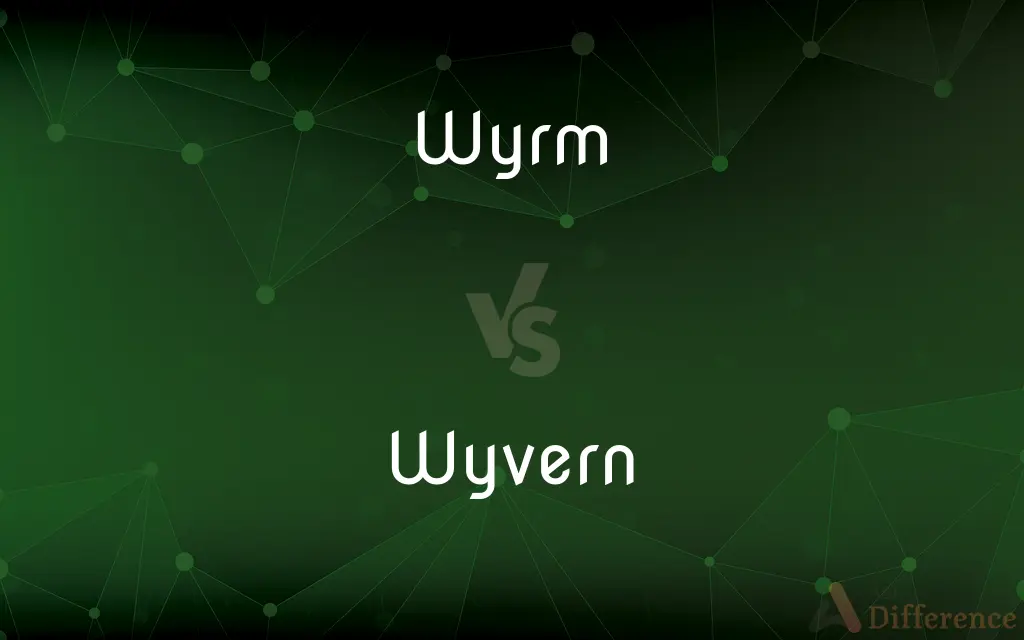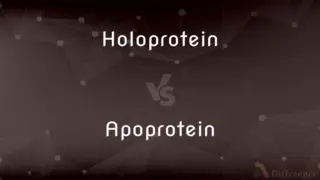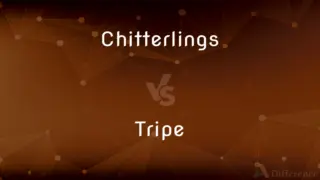Wyrm vs. Wyvern — What's the Difference?
Edited by Tayyaba Rehman — By Maham Liaqat — Updated on May 3, 2024
Wyrms are legless, serpent-like dragons in European mythology, primarily focused on burrowing or aquatic environments; wyverns are winged, two-legged dragons, often depicted in heraldry and medieval folklore.

Difference Between Wyrm and Wyvern
Table of Contents
ADVERTISEMENT
Key Differences
Wyrms are depicted as legless and sometimes wingless creatures in European folklore, resembling large serpents or worms. In contrast, wyverns possess a distinctive physical form with two legs and a pair of wings, which sets them apart visually and in their mythological roles.
In terms of habitat, wyrms are often associated with underground or underwater environments, aligning with their serpentine bodies that allow for burrowing and swimming. Wyverns, however, are typically found in the air or perched atop castles and cliffs, reflecting their aerial abilities.
Wyrms in mythology tend to be symbols of earth and water, embodying the primal aspects of nature. Wyverns, on the other hand, are more commonly associated with fire and air, often used in heraldry to symbolize warlike fierceness and protection.
The role of wyrms in stories often revolves around being ancient guardians of treasures or secrets, emphasizing their mysterious and ancient nature. Wyverns are frequently portrayed as adversaries in knightly quests and battles, highlighting their aggressive and menacing traits.
While wyrms are often considered more ancient and sometimes wise creatures in folklore, wyverns are depicted as less intelligent but more fierce and aggressive, making them popular figures in medieval battles and heraldic symbolism.
ADVERTISEMENT
Comparison Chart
Limbs
Legless, sometimes wingless
Two legs and two wings
Common Depictions
Serpent-like, elongated body
Dragon-like with a barbed tail
Habitat
Underground or aquatic
Aerial or on rocky outcrops
Symbolism
Earth, water, ancient wisdom
Fire, air, warfare, protection
Role in Folklore
Guardians of secrets/treasures
Adversaries in quests and battles
Compare with Definitions
Wyrm
In modern fantasy, a large, powerful serpent often involved in magic or epic tales.
The wyrm in the novel could speak and cast spells.
Wyvern
A two-legged dragon with a barbed tail, commonly featured in medieval heraldry.
The knight's shield bore a red wyvern, symbolizing bravery and war.
Wyrm
A symbol of deep earth forces in mythology, associated with wisdom and longevity.
The wyrm was often consulted by heroes on their quests for its ancient knowledge.
Wyvern
In fantasy games, a common enemy type, known for aerial attacks.
Players must dodge the wyvern's fiery breath to survive the encounter.
Wyrm
In games and literature, a creature challenging to defeat due to its size and power.
Defeating the wyrm required not only strength but clever strategy.
Wyvern
Used symbolically to represent protection and strength in heraldic crests.
The royal family's crest featured a wyvern, guarding the lineage's honor.
Wyrm
A mythological dragon-like creature, usually depicted without legs or wings.
The ancient wyrm guarded the underground treasures for centuries.
Wyvern
Associated with tales of heroism, where defeating one is a rite of passage for knights.
The young knight's quest to slay the wyvern proved his worth to the kingdom.
Wyrm
Sometimes used metaphorically to describe insidious or creeping dangers.
Corruption was the wyrm that slowly ate away at the kingdom from within.
Wyvern
Often depicted as a fearsome creature in literature and films.
The wyvern swooped down from the sky, causing chaos among the villagers.
Wyrm
A huge limbless and wingless dragon or dragon-like creature.
Wyvern
A wyvern ( WY-vərn, sometimes spelled wivern) is a legendary bipedal winged dragon usually depicted with a tail ending in a diamond- or arrow-shaped tip.The wyvern in its various forms is important to heraldry, frequently appearing as a mascot of schools and athletic teams (chiefly in the United States, United Kingdom, and Canada). It is a popular creature in European literature, video games, and modern fantasy.
Wyrm
A sea serpent.
Wyvern
A two-legged dragon having wings and a barbed tail.
Wyvern
A draconian creature possessing wings, only two legs and usually a barbed tail.
Wyvern
Same as Wiver.
Wyvern
A fire-breathing dragon used in medieval heraldry; had the head of a dragon and the tail of a snake and a body with wings and two legs
Common Curiosities
Can wyrms be found in modern stories?
Yes, wyrms frequently appear in modern fantasy literature and games, usually as formidable creatures embodying ancient magic and wisdom.
What symbolism is associated with wyverns in heraldry?
In heraldry, wyverns symbolize strength, protection, and valor, often used to represent martial prowess and defense.
What kind of attacks do wyverns typically use in fantasy games?
Wyverns often use aerial attacks, including swooping and breathing fire, making them challenging opponents in games.
Do wyverns have any specific weaknesses in folklore or literature?
In folklore, wyverns are often defeated through the heroism of knights; weaknesses might include their underbelly or the joints of their wings.
Are wyrms considered more intelligent than wyverns?
In many stories, wyrms are depicted as wiser and more cunning than wyverns, possibly due to their ancient and mythical nature.
What is the typical size comparison between a wyrm and a wyvern?
Wyrms are often depicted as larger and longer due to their serpentine nature, while wyverns, though large, are more compact due to their draconic body structure.
How are wyrms typically defeated in myths?
Defeating a wyrm often requires clever strategy and magical assistance, reflecting their portrayal as deeply entrenched and powerful creatures.
Are wyrms capable of flight?
Typically, wyrms are not capable of flight due to their legless, serpentine body structure.
How do wyrms and wyverns differ in their roles in mythology?
Wyrms are often portrayed as ancient guardians of knowledge and treasures, whereas wyverns are more commonly seen as aggressive creatures that knights and heroes must overcome.
What is the typical habitat of a wyvern?
Wyverns are usually found in high, rocky places or soaring in the sky.
Do wyverns play a role in any famous legends or historical coats of arms?
Yes, wyverns appear in several European coats of arms and are featured in numerous medieval and Renaissance legends as formidable adversaries.
What are some popular books or movies that feature wyrms?
Wyrms appear in various high fantasy novels and series, where they are often depicted as ancient beings with deep lore.
What is a wyrm?
A wyrm is a legless, often wingless dragon-like creature from European mythology, typically associated with the earth or water elements.
What does a wyvern look like?
A wyvern is a dragon-like creature with two legs and two wings, often depicted with a barbed tail.
Share Your Discovery

Previous Comparison
Holoprotein vs. Apoprotein
Next Comparison
Chitterlings vs. TripeAuthor Spotlight
Written by
Maham LiaqatEdited by
Tayyaba RehmanTayyaba Rehman is a distinguished writer, currently serving as a primary contributor to askdifference.com. As a researcher in semantics and etymology, Tayyaba's passion for the complexity of languages and their distinctions has found a perfect home on the platform. Tayyaba delves into the intricacies of language, distinguishing between commonly confused words and phrases, thereby providing clarity for readers worldwide.













































